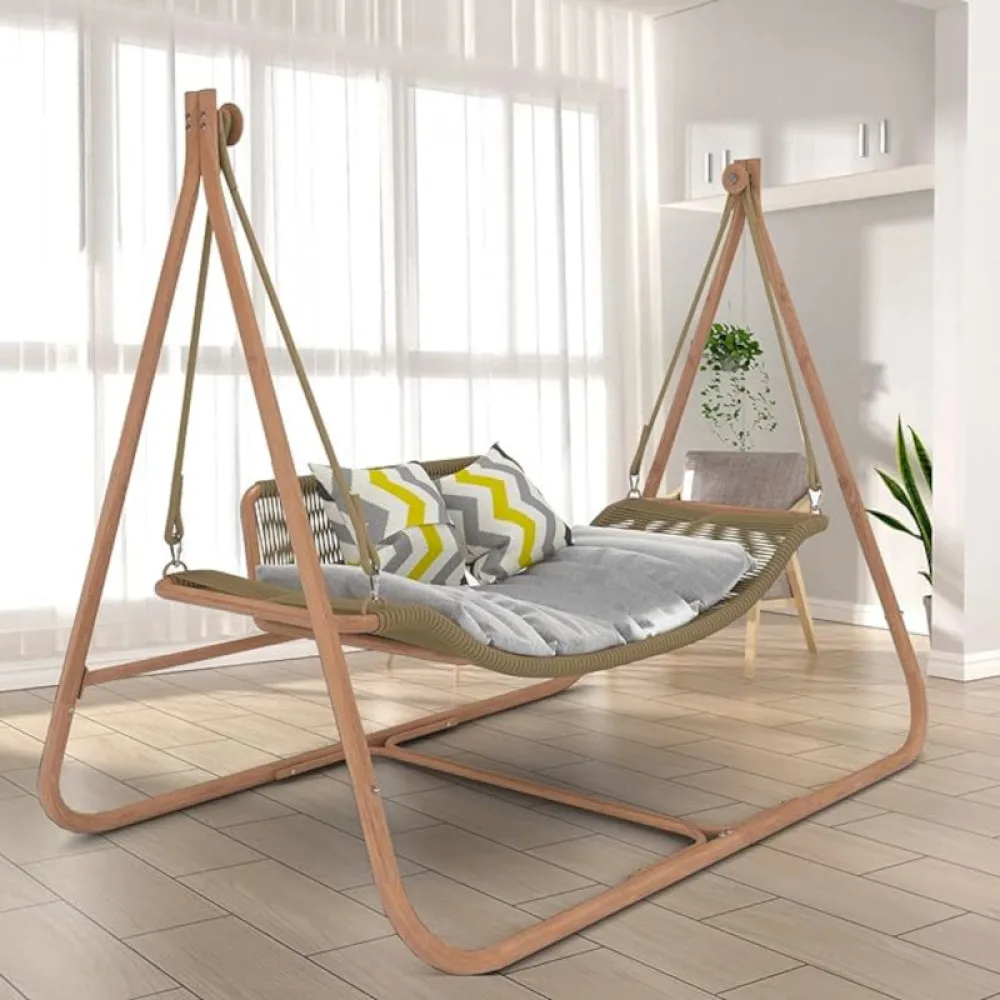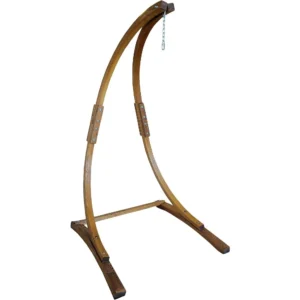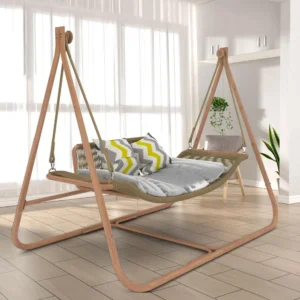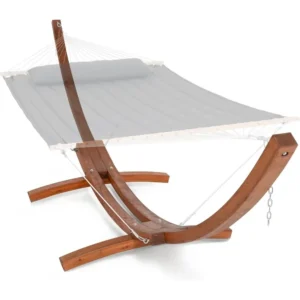The Unmatched Comfort Revolution: Why Swing Chairs Elevate Patio Relaxation
Patio swing chairs represent a fundamental shift in how we experience outdoor relaxation. Unlike traditional static furniture that keeps you fixed in one position, swing chairs introduce a gentle, rhythmic movement that transforms a simple sitting experience into something truly special. This perpetual, subtle motion engages your body’s vestibular system—the sensory network responsible for balance and spatial orientation—creating a profoundly calming effect that static furniture simply cannot match.
The science behind this comfort is fascinating. The gentle swaying motion of swing chairs has been shown to reduce stress hormones like cortisol while simultaneously boosting endorphin production. This natural rocking mimics sensations we found comforting from our earliest days, activating deep-seated relaxation responses in our nervous system. Many users report that even brief sessions in a swing chair can significantly lower perceived stress levels and promote a sense of wellbeing.
From an ergonomic perspective, quality swing chairs offer distinct advantages over conventional patio seating. Their suspended design naturally conforms to your body’s contours, providing support precisely where needed. The slight “micromotion” required to balance in a swing chair engages your core muscles subtly but continuously, promoting better posture without conscious effort. This gentle engagement helps prevent the stiffness that often comes with sitting in fixed positions for extended periods.
Perhaps most distinctive is the cocoon-like feeling that swinging hammock chairs create. This semi-enclosed design establishes a personal sanctuary within your outdoor space—a boundary that feels both protective and freeing. This psychological comfort combines with physical comfort to create an experience that many describe as transformative, turning ordinary relaxation into a multi-sensory retreat.
The benefits of swing chair comfort include:
– Vestibular stimulation that naturally reduces stress and anxiety
– Gentle core engagement that improves posture without strain
– Adaptable support that conforms to individual body shapes
– Cocoon-like enclosure that creates psychological comfort and security
Whether you’re seeking respite from a hectic day or creating a permanent relaxation station, patio-friendly swinging hammock chairs offer a comfort experience that fundamentally differs from standard outdoor furniture.
Creating a Visual Statement: How Swing Chairs Transform Patio Aesthetics
Beyond their comfort advantages, swing chairs serve as compelling visual focal points that instantly elevate any patio’s design profile. Their distinctive suspended forms create visual intrigue through their unexpected dimensionality, breaking the horizontal monotony typical of traditional outdoor furniture arrangements. This vertical element draws the eye upward, making even modest patio spaces feel more expansive and architecturally interesting.
The suspended nature of many swing chair designs creates a sense of airiness and visual lightness that contrasts beautifully with the solid elements of your patio. This juxtaposition between floating seating and grounded surroundings creates a dynamic tension that sophisticated interior designers often seek to achieve. Even freestanding swing chairs with dedicated frames introduce elegant curved elements and negative space that static furniture cannot replicate.
The design versatility of swinging hammock chair sets allows them to enhance virtually any aesthetic direction. Bohemian-inspired rope hammock chairs with macramé details and tasseled edges bring artistic, handcrafted character to casual outdoor spaces. For contemporary patios, sleek egg-shaped chairs with minimalist cushioning create sculptural statements that complement modern architecture. Traditional spaces benefit from classic wooden swing designs with gently curved supports and timeless proportions.
Swing chairs also excel at creating defined “zones” within larger patio areas—establishing natural boundaries without walls or barriers. A strategically placed swing chair instantly demarcates a reading nook, conversation area, or meditation space through its distinctive form and function. This subtle spatial organization helps make expansive outdoor areas feel purposeful and intimate rather than undefined.
The aesthetic impact of swing chairs extends beyond daylight hours as well. Their distinctive silhouettes create compelling shadows and can be enhanced with strategic lighting to become even more dramatic focal points during evening gatherings. When selected thoughtfully, a swing chair becomes not just furniture, but a defining design element that expresses personal style while elevating the entire outdoor living experience.
Space-Smart Solutions: Maximizing Your Patio’s Potential with Swing Chairs
Swing chairs offer remarkable space efficiency that makes them ideal for patios of all dimensions. Unlike conventional seating arrangements that demand significant square footage, these versatile pieces work within spatial constraints while maximizing comfort and style. Their adaptability makes them particularly valuable for today’s outdoor living environments, where making the most of available space has become increasingly important.
For compact patios, hanging swing chairs provide an ingenious solution by utilizing vertical space that would otherwise remain empty. By suspending from a ceiling, pergola, or sturdy tree branch, these chairs create comfortable seating without consuming precious floor area. This elevation also creates the illusion of more space by keeping sightlines open and floor areas uncluttered. Meanwhile, perfectly positioning swing hammock chairs in small spaces requires careful planning but delivers outsized benefits.
For those without suitable overhead attachment points, freestanding swing chair models offer similar benefits with added flexibility. These self-contained units typically require a footprint similar to or smaller than traditional lounge chairs, yet provide a more immersive seating experience. Their movability allows for seasonal repositioning or temporary relocation when entertaining larger groups—an adaptability that static furniture arrangements simply cannot match.
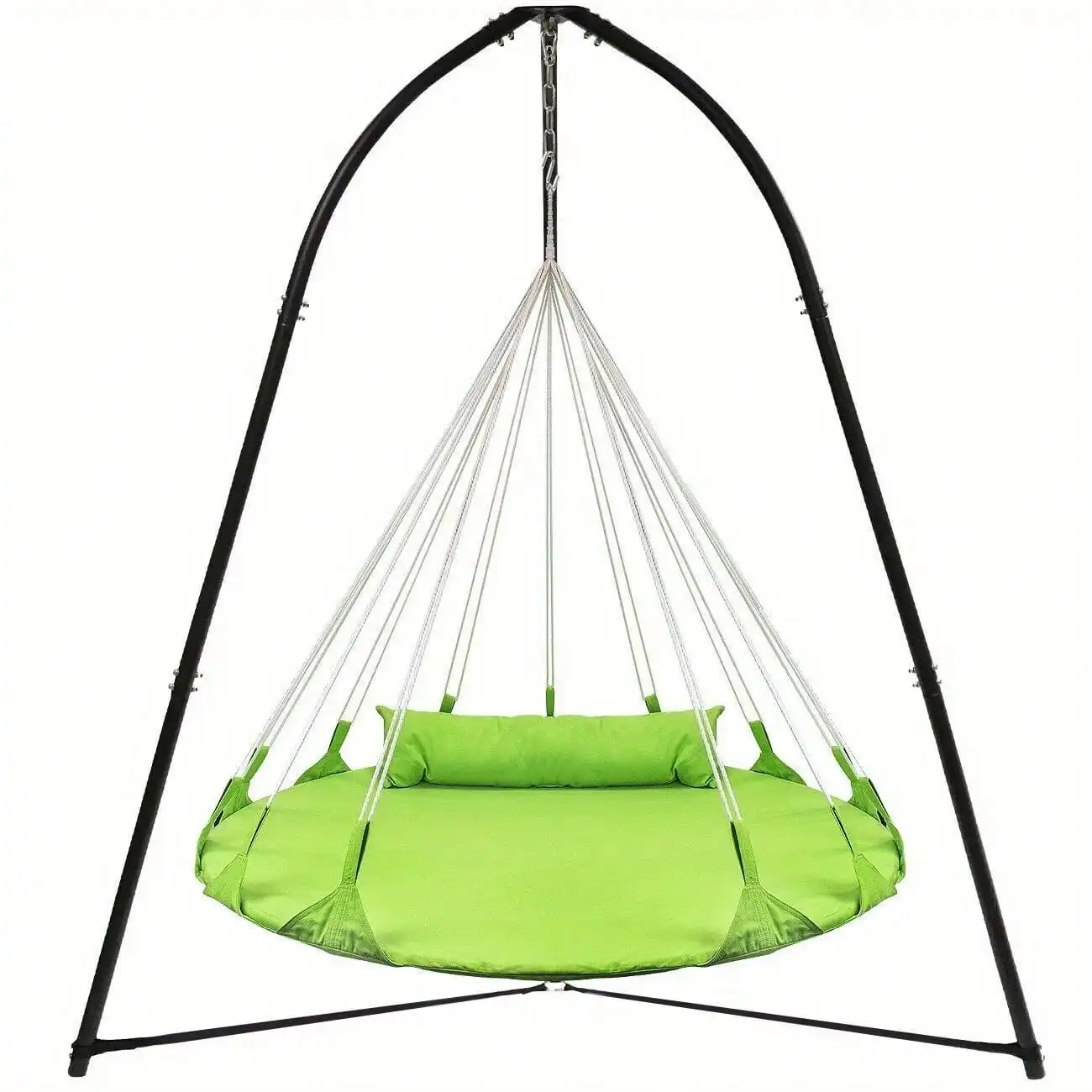
Key space advantages of patio swing chairs include:
- Vertical utilization that preserves valuable floor space
- Smaller footprints compared to equivalent comfort in traditional seating
- Visual lightness that makes spaces appear more open
- Flexible positioning for different occasions and seasons
- Zone-defining capability without bulky furniture arrangements
Even placement considerations support their space efficiency. While swing chairs need some clearance for movement, their contained swing arc typically requires less total area than the circulation space needed around conventional seating groups. With thoughtful placement, swing chairs create comfortable retreats while respecting spatial limitations—proving that remarkable outdoor experiences don’t necessarily demand expansive square footage.
Weather-Worthy Wonders: The Remarkable Durability of Modern Patio Swing Chairs
Today’s patio swing chairs represent a triumph of materials science, offering exceptional durability that withstands diverse weather conditions while maintaining their comfort and visual appeal. These resilient outdoor furnishings bear little resemblance to fragile predecessors, instead incorporating sophisticated materials and construction techniques specifically engineered for outdoor exposure.
Modern synthetic wicker, a common material in contemporary swing chair design, exemplifies this advancement. Unlike natural rattan that deteriorates rapidly outdoors, these high-density polyethylene fibers resist UV degradation, moisture damage, and temperature fluctuations. Quality synthetic wicker remains flexible and attractive for years, even with minimal protection from the elements. Similarly, powder-coated aluminum frames offer the visual lightness of metal without corrosion concerns, as their electrostatic bonded finish creates a virtually impenetrable moisture barrier.
For those preferring natural materials, today’s wooden swing chairs utilize sophisticated preservation techniques that dramatically extend their outdoor lifespan. Teak, acacia, and cedar options contain natural oils that resist water penetration and insect damage, while additional treatments enhance these inherent properties without compromising environmental safety or aesthetic appeal. These advancements mean wooden swing chairs now require significantly less maintenance while lasting substantially longer than earlier generations of outdoor wood furniture.
Fabric components have seen equally impressive innovation. High-performance textiles used in weather protection for patio hammock chairs now incorporate solution-dyed acrylics with built-in UV inhibitors that resist fading for years, not months. Quick-dry foam technologies prevent waterlogging and mildew growth in cushions, while advanced water-repellent treatments allow rain to bead off rather than penetrate. These fabrics maintain their color integrity and structural strength through seasonal transitions that would quickly degrade standard materials.
What’s particularly notable is how these durability enhancements come without sacrificing comfort or style. Unlike utilitarian outdoor furniture that emphasizes function over form, modern swing chairs achieve remarkable weather resistance while maintaining the plush comfort and aesthetic sophistication that make them such compelling outdoor additions. This combination of resilience and refinement ensures that today’s investment in a quality swing chair delivers years of enjoyment with minimal maintenance requirements.
The Multi-Functional Magic: Beyond Simply Sitting
Patio swing chairs transcend the limited functionality of conventional outdoor seating by serving multiple purposes throughout the day and across seasons. Their versatility transforms them from simple furniture pieces into dynamic activity centers that adapt to changing needs and desires. This multi-functionality significantly enhances their value proposition and daily utility.
Morning brings one of the swing chair’s most cherished roles—creating the perfect coffee retreat. The gentle swaying motion pairs naturally with that first cup, the enclosed design blocking morning breezes while you ease into the day. Many users report that this morning ritual in their swing chair sets a positive tone that carries through their entire day, creating a mindfulness moment before daily demands begin.
As the day progresses, the same chair effortlessly transforms into a focused reading sanctuary. The semi-enclosed design naturally blocks peripheral distractions, while the gentle motion helps maintain alertness without tension. The ergonomic support allows for extended reading sessions without the discomfort that often cuts reading time short in conventional chairs. Hammock chairs with stands provide this experience without requiring permanent installation.
- Meditation and mindfulness practice space
- Remote work or creative thinking environment
- Afternoon napping or rest station
- Evening conversation and relaxation pod
- Stargazing and night sky observation point
This adaptability extends to different users as well. The same swing chair that serves as a parent’s quiet retreat becomes a child’s imaginary spaceship or reading nook later in the day. Teenagers find them perfect for both socializing and retreating with headphones. This multi-generational appeal makes swing chairs unique among outdoor furnishings, serving diverse family members without requiring multiple specialized seating options.
The dedicated “purpose space” a swing chair creates also holds psychological benefits. Having a designated area for relaxation or reflection helps establish healthy boundaries between activities, supporting better mental transitions between work, family time, and personal renewal—all within the same outdoor living area.
The Social Hub: Fostering Connection in Your Outdoor Space
Swing chairs possess a remarkable ability to transform the social dynamics of patio gatherings, creating opportunities for more meaningful connections and comfortable interactions. Their unique design naturally facilitates conversation while simultaneously providing psychological comfort that encourages more open communication. This combination makes them powerful catalysts for social bonding in outdoor settings.
The gentle motion of swing chairs creates a relaxed psychological state that visitors immediately respond to. “Every time friends come over, they gravitate straight to our patio swing,” notes one owner. “There’s something about that slight swaying that helps people let their guard down.” This relaxation effect is particularly valuable when hosting guests who might normally feel awkward or formal in unfamiliar settings. The chair’s movement provides a subtle activity that fills conversational pauses without requiring electronic distractions.
The semi-enclosed design of many swing chairs creates what psychologists call a “conversation nook”—a partially defined space that feels both private and accessible. This architectural psychology principle explains why discussions often become deeper and more meaningful in these semi-sheltered environments. Guests feel simultaneously protected and engaged, striking the perfect balance between exposure and privacy that facilitates authentic connection.
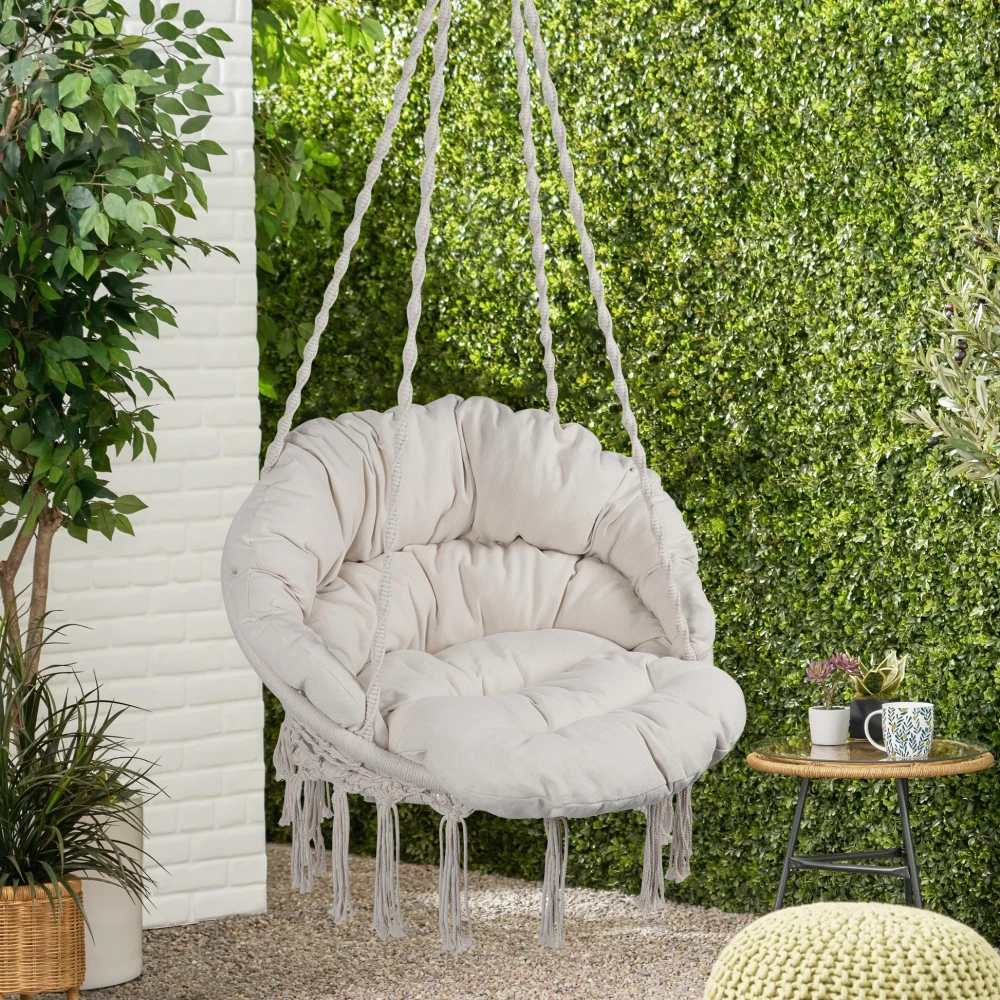
The experience is particularly transformative for those who struggle with social anxiety. The contained feeling of a swing chair provides a sense of personal boundary while still allowing full participation in group activities. “I always felt awkward at outdoor gatherings until my friend got her swing chair,” shares one previously hesitant socializer. “Having that defined space gave me just enough security to relax and actually enjoy myself.”
For families, deep seat chair hammock sets often become natural gathering points for multi-generational interaction. Grandparents find them comfortable for extended sitting, while their gentle motion appeals to children’s natural energy. This creates rare spaces where different generations naturally want to occupy the same area, fostering intergenerational bonds through proximity and shared experience.
Beyond their physical characteristics, swing chairs possess an almost magical ability to become what sociologists call “sticky spaces”—areas that draw people in and encourage them to linger. By creating these compelling social anchors on your patio, you naturally extend outdoor gatherings and deepen the connections formed during them.
The Wellness Factor: Mental and Physical Benefits Beyond Comfort
The benefits of patio swing chairs extend far beyond simple comfort, contributing significantly to holistic wellness through multiple physiological and psychological pathways. These health advantages, while subtle individually, combine to create meaningful improvements in both mental and physical wellbeing with regular use.
From a mental health perspective, the gentle rocking motion of swing chairs triggers the brain’s relaxation response, reducing cortisol levels while increasing beneficial neurotransmitters like serotonin. This biochemical shift helps explain why time spent in swing chairs consistently reduces perceived stress and anxiety. The semi-enclosed design also creates a psychological boundary that helps users mentally disconnect from obligations and worries—a crucial factor in effective stress recovery.
This mental restoration is amplified by the outdoor positioning of patio swing chairs. Exposure to natural light regulates circadian rhythms and vitamin D production, while the sensory diversity of outdoor environments—changing light patterns, gentle sounds, natural fragrances—engages what neuroscientists call “soft fascination,” a form of attention that restores cognitive resources rather than depleting them. Porch swing hammocks provide an ideal platform for experiencing these benefits.
Physical benefits parallel these mental advantages. The gentle movement in swing chairs improves circulation by preventing the blood pooling that occurs in static seating. The subtle balance adjustments required stimulate proprioception—the body’s position sense—which often deteriorates with age or sedentary lifestyles. This mild vestibular stimulation also supports better balance and coordination over time, potentially reducing fall risk.
Key wellness benefits include:
- Stress reduction through gentle motion and sensory engagement
- Improved mood via increased serotonin and outdoor light exposure
- Enhanced circulation through subtle movement and position changes
- Better sleep quality following regular relaxation sessions
- Reduced muscle tension compared to static seating options
- Mindfulness facilitation through comfortable, focused experiences
Perhaps most significant is how swing chairs encourage what health researchers call “restorative breaks”—short periods of genuine relaxation that interrupt stress patterns and allow for mental and physical recovery. In today’s achievement-focused culture, these legitimate pauses are increasingly rare yet critically important for sustainable wellbeing. By creating an inviting, dedicated space for such breaks, swing chairs don’t just offer comfort—they actively promote healthier lifestyle patterns.
The Investment Perspective: Value Beyond the Price Tag
When evaluating patio swing chairs from a financial perspective, their value proposition extends far beyond the initial purchase price. These distinctive outdoor furnishings represent a strategic investment in lifestyle quality with tangible returns across multiple dimensions. Understanding this broader value context helps justify what might initially seem like a premium purchase.
Quality swing chairs demonstrate remarkable longevity compared to standard patio furniture. While typical outdoor seating often requires replacement every 2-3 seasons, well-constructed swing chairs frequently deliver 7-10 years of service with proper care. This extended useful life significantly reduces the actual annual cost of ownership despite higher initial pricing. Heavy duty hammock sets particularly excel in this longevity metric, often becoming the most durable elements of an outdoor furniture collection.
Beyond physical durability, swing chairs maintain their aesthetic appeal and functionality longer than trend-driven furniture pieces. Their distinctive design represents a more timeless approach to outdoor living, resisting the rapid style obsolescence that affects many seasonal furniture trends. This design longevity means swing chairs rarely need replacement for stylistic reasons, further enhancing their long-term value proposition.
The usage intensity of swing chairs also contributes to their exceptional value. While many patio furniture pieces see only occasional use, swing chairs typically become daily destinations. This higher utilization rate means their cost-per-use drops dramatically compared to seldom-used decorative items. One owner calculated that her seemingly expensive swing chair, used daily for just 20 minutes, reached a cost-per-use of less than 25 cents within the first year alone.
Property enhancement represents another value dimension. Real estate professionals note that well-designed outdoor living spaces can increase property valuation by 5-15%, with distinctive features like quality swing chairs contributing to this premium. Even for those not planning to sell, this represents real value appreciation rather than pure expense.
Perhaps most significantly, swing chairs deliver experiential value that transcends conventional furniture utility. By creating daily opportunities for stress reduction, connection, and wellbeing, they generate ongoing lifestyle benefits that would otherwise require external services or experiences. This “wellness amenity” aspect makes swing chairs unique among outdoor furnishings—they’re not just places to sit, but experiences to enjoy and benefit from daily.
Swing Chair Styles Decoded: Finding Your Perfect Match
The world of patio swing chairs encompasses diverse design approaches, each offering distinct aesthetic and functional characteristics. Understanding these style categories helps identify the perfect match for your outdoor space and personal preferences.
Bohemian swing chairs embrace artistic expression through natural materials, handcrafted details, and organic shapes. Characterized by macramé patterns, fringe elements, and visible textures, these chairs bring a relaxed, globally-inspired aesthetic to outdoor spaces. Typically featuring cotton or jute rope construction, bohemian styles create visual interest through intricate knotwork and flowing lines. They pair beautifully with eclectic outdoor decor, potted plants, and natural wood elements, establishing a laid-back atmosphere that invites creativity and relaxation.
Contemporary swing designs prioritize clean lines, architectural shapes, and modern materials. These sleek interpretations often feature:
– Geometric forms with precise angles or perfect curves
– Monochromatic color schemes with occasional bold accents
– Innovative materials like powder-coated metals and performance fabrics
– Minimal ornamentation with emphasis on structural elegance
These modern interpretations complement architectural outdoor spaces and create dramatic visual statements through form rather than decoration.
Traditional swing chair styles reference classical design elements with attention to symmetry, craftsmanship, and timeless proportions. Typically constructed from natural hardwoods with careful joinery and gentle curves, these chairs convey permanence and heritage. Their balanced forms and familiar silhouettes create immediate comfort through recognition, while their refined details reward closer inspection. Traditional designs integrate seamlessly with classic garden elements and architectural features.
For those seeking versatility, transitional swing chairs blend elements from different style categories, creating adaptable pieces that work across design contexts. These balanced designs incorporate selected traditional elements within more contemporary frameworks, resulting in chairs that neither feel trendy nor overly formal. Hanging egg chair sets often exemplify this versatile approach, with their distinctive form working equally well in modern or more traditional settings.
Minimalist interpretations focus on essential elements, removing anything superfluous to create pure expressions of function. These restrained designs use careful proportions and quality materials rather than elaborate details to create their aesthetic impact. The visual simplicity of minimalist swing chairs makes them particularly effective in already-busy outdoor environments, where they provide visual breathing space while still offering distinctive comfort.
Material Matters: Choosing the Right Composition for Your Climate
The materials used in patio swing chairs significantly impact their performance, maintenance requirements, and longevity in specific climate conditions. Making informed material choices based on your local weather patterns ensures both lasting enjoyment and minimal upkeep.
In humid coastal environments, synthetic materials typically outperform natural alternatives. High-density polyethylene (HDPE) wicker resists moisture absorption that would quickly deteriorate natural rattan, while maintaining its aesthetic appeal season after season. These engineered materials prevent the mold and mildew issues that often plague natural fibers in high-humidity settings. Similarly, powder-coated aluminum frames resist the corrosive effects of salt air that would quickly compromise standard steel constructions, maintaining their structural integrity without requiring special treatments or coverings.
For hot, sunny climates, UV-resistance becomes the primary consideration. Premium synthetic fabrics with solution-dyed colors maintain their vibrancy despite intense sun exposure that would quickly fade standard textiles. The color in these materials runs throughout the fiber rather than sitting on the surface, providing exceptional fade resistance. Specialized patio hammock chair materials also incorporate heat-reflective properties that keep surfaces comfortable even in direct sunlight—a crucial feature for maintaining usability during hot afternoons.
Cold-weather regions present different challenges, making material flexibility and freeze-thaw resistance essential. Weather-treated hardwoods like teak or acacia demonstrate remarkable resilience in these conditions, as their natural oils prevent moisture penetration that would otherwise lead to cracking during freeze cycles. For cushions and textiles, quick-dry foam cores and moisture-wicking fabrics prevent water retention that could freeze and damage the material structure.
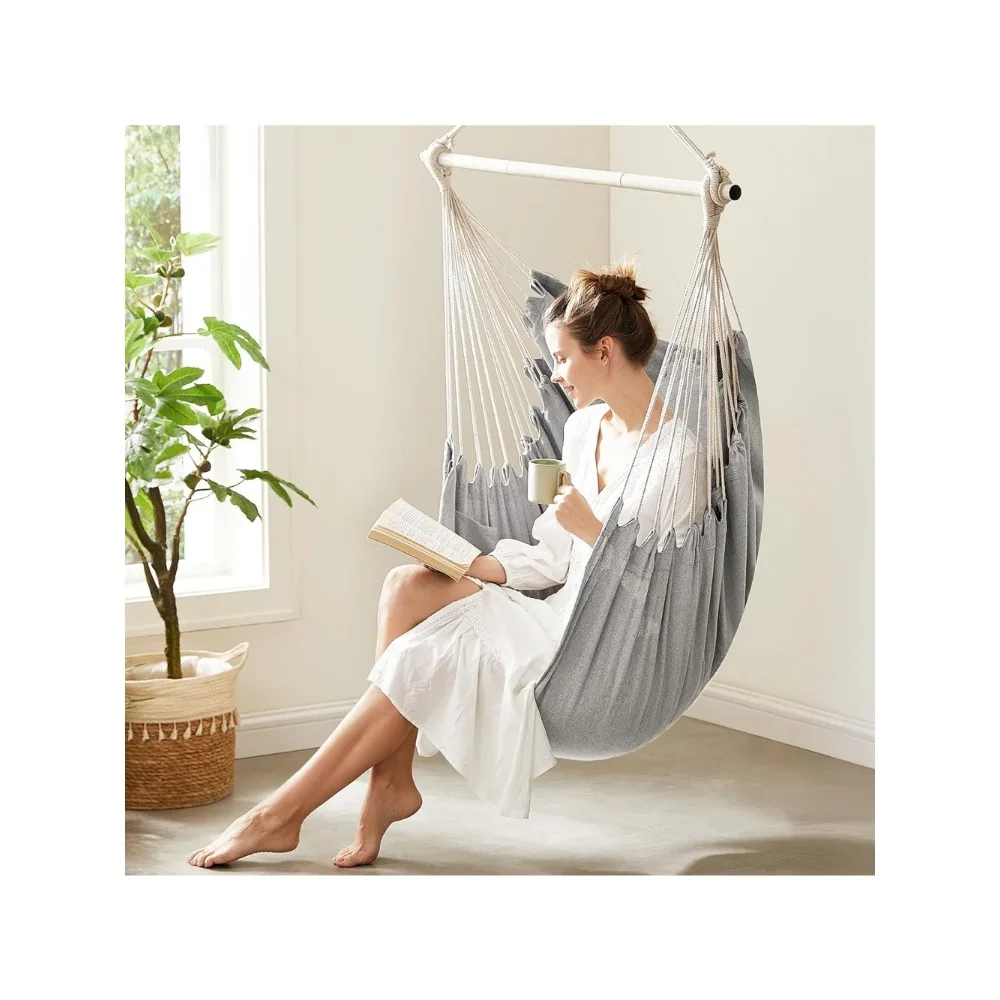
For those in variable climates with distinctive seasons, material combinations often provide the best solution. Frames constructed from durable weather-resistant materials paired with removable cushions allow for seasonal adaptation. High-performance covers designed specifically for outdoor furniture provide additional protection during extreme weather periods, extending the functional season and overall lifespan.
Maintenance requirements vary significantly between materials:
– Synthetic wicker requires only occasional cleaning with mild soap and water
– Teak develops a silvery patina unless treated with oil every 1-2 seasons
– Powder-coated metals need periodic inspection for scratches that might allow corrosion
– Performance fabrics benefit from gentle cleaning after heavy pollen seasons
Understanding these material characteristics ensures that your swing chair remains both beautiful and functional despite whatever weather challenges your specific climate presents.
Dark Wood Hammock Sets, Porch Swing Chair Sets
$653.82 Select options This product has multiple variants. The options may be chosen on the product pageA-Frame Stand Hammock Sets, Swinging Hammock Chair Sets
$154.62 Select options This product has multiple variants. The options may be chosen on the product pageLight Wood Hammock Sets, Swinging Hammock Chair Sets
$1,359.35 Select options This product has multiple variants. The options may be chosen on the product pageClassic Wooden Stand Hammock Sets, Heavy Duty Hammock Sets
$1,061.68 Select options This product has multiple variants. The options may be chosen on the product pageHammock Sets with Canopy, Heavy Duty Hammock Sets
$286.31 Select options This product has multiple variants. The options may be chosen on the product pageHeavy Duty Hammock Sets, Wooden Arc Stand Hammock Sets
$878.66 Select options This product has multiple variants. The options may be chosen on the product page
Installation and Setup: Ensuring Safety and Stability
Proper installation of patio swing chairs is essential for both safety and optimal enjoyment. Different chair designs require specific setup approaches, with each presenting unique considerations to ensure secure, reliable performance.
Hanging swing chairs require careful attention to structural support. These suspended designs transfer their entire load—both the chair weight and occupant—to a single attachment point, necessitating robust support systems. Ceiling joists, substantial tree limbs, or dedicated support beams must have sufficient load capacity, typically at least 300-400 pounds for standard models. Professional installation may be warranted for ceiling-mounted options to ensure proper hardware selection and secure attachment to structural elements rather than merely decorative surfaces.
Freestanding swing chair frames provide greater placement flexibility but require level, stable surfaces. These self-supporting structures distribute weight across multiple contact points, making surface stability crucial. On wooden decks, positioning the frame legs over joists rather than between them prevents excessive flexing and potential damage. For stone or concrete patios, protective feet prevent surface scratching while ensuring full contact across all support points. The ultimate swinging chair installation depends on thoughtful positioning and proper weight distribution.
Clearance requirements deserve special attention during setup. Most swing chairs need 3-4 feet of clear space in all directions to allow safe, comfortable movement. This clearance should account for the chair’s maximum swing arc, not just its resting position. Inadequate clearance not only limits the enjoyment of the chair’s motion but can create collision hazards with nearby objects or structures.
Weight capacity specifications must be strictly observed. Quality swing chairs clearly state their maximum weight limits, which typically range from 250-400 pounds depending on design and materials. These ratings reflect comprehensive testing and safety margins; exceeding them compromises both safety and longevity. Families should select models with appropriate capacity for their largest potential users, not average users.
Regular inspection becomes an essential maintenance routine after installation. Check attachment points, hardware connections, and support structures at the beginning of each season and periodically during heavy use. This preventive approach identifies potential issues before they create safety hazards or require costly repairs. Tightening loose connections, replacing worn hardware, and addressing minor damage promptly extends the safe service life of your swing chair investment.
Must-Have Features: Comfort Enhancements Worth the Investment
When selecting a patio swing chair, certain comfort-enhancing features significantly improve the overall experience and represent worthwhile investments despite their potential premium. Understanding these key elements helps prioritize features that deliver genuine value rather than merely decorative additions.
Premium cushioning stands as perhaps the most impactful comfort enhancement. High-quality cushions with adequate thickness (typically 3-5 inches) provide proper support distribution and prevent pressure points during extended sitting. The best options combine multiple foam densities—firmer base layers for support with softer top layers for surface comfort. Patio swing chair features like contoured cushioning that follows body contours deliver noticeably superior comfort compared to flat alternatives, particularly for longer relaxation sessions.
Cushion fabric quality directly affects both comfort and longevity. Superior options include:
– Solution-dyed acrylics with 5+ year color warranties
– Quick-dry technologies that prevent water retention
– Antimicrobial treatments that resist mildew and odors
– Soft-touch finishes that remain comfortable against bare skin
While these performance fabrics command higher prices, their extended lifespan and reduced maintenance requirements justify the additional investment.
Adjustable features significantly enhance adaptability to different users and activities. Reconfigurable backrests accommodate various seating positions from upright conversation to reclined reading. Removable headrests provide neck support when desired while allowing more active movement when not needed. Swing chairs offering these adaptations effectively serve as multiple furniture pieces in one, increasing their functional value.
Weather protection elements extend both comfort and usability. Integrated canopies or adjustable hoods provide crucial shade during peak sun hours, expanding comfortable use periods throughout the day. Removable rain covers allow quick protection during sudden showers without requiring complete furniture relocation. These protective features extend the practical season of use, enhancing the overall value proposition.
Thoughtful convenience additions—while seemingly small—significantly enhance daily enjoyment. Side pockets keep reading materials within easy reach, cup holders prevent spill accidents, and small integrated tables provide convenient surfaces for snacks or electronic devices. These practical elements transform comfort from merely physical to comprehensive, addressing both body and activity needs in one thoughtful design.
Seasonal Care: Maintaining Your Swing Chair for Years of Enjoyment
Proper seasonal maintenance dramatically extends the lifespan of patio swing chairs while preserving their comfort and appearance. Following a structured care program tailored to changing weather conditions ensures your investment continues delivering enjoyment for many years.
Spring maintenance lays the foundation for the upcoming high-use season. Begin with a thorough inspection of all structural components—check hanging hardware for signs of corrosion, examine frame connections for winter damage, and test moving parts for proper function. Clean accumulated winter debris using appropriate methods for your chair’s materials: gentle detergent solutions for synthetics, specialized wood cleaners for natural materials. This is also the ideal time to refresh protective treatments like fabric guards or wood sealants before heavy use begins.
Summer care focuses on preserving materials during peak exposure conditions. Regular light cleaning prevents staining from bird droppings, tree sap, or food spills that can become permanent when baked by summer heat. Position chairs to avoid constant direct sunlight when not in use, or utilize covers during extended absence periods. For fabric components, periodic gentle brushing removes pollen and environmental debris that can hold moisture against surfaces and accelerate deterioration.
Fall preparation transitions the chair toward lower-use seasons. More thorough cleaning removes accumulated summer residues before they can cause long-term staining or material damage. This season is ideal for addressing minor repairs—tightening loose connections, touching up surface treatments, or replacing any worn components before winter exposure tests them further. For hanging models, checking suspension systems becomes particularly important as temperature fluctuations may have affected tension or connection points.
Winter protection strategies vary by climate severity and storage options. In mild winter regions, quality furniture covers provide sufficient protection while maintaining outdoor accessibility. These covers should be waterproof yet breathable to prevent condensation buildup that promotes mildew. For harsh winter areas, complete dismantling and indoor storage offers optimal protection, particularly for cushions and fabric components. If full storage isn’t possible, elevating chairs to prevent ground moisture contact and securing against wind damage becomes essential.
Throughout all seasons, porch swing chair sets benefit from prompt attention to any damage or wear. Addressing small issues immediately prevents escalation to more serious problems and helps maintain both safety and appearance. This proactive approach to care not only extends furniture life but ensures your swing chair remains a consistent source of comfort and enjoyment across changing seasons.
Beyond the Basic Swing: Creative Enhancements for Your Chair
Thoughtfully selected enhancements can transform a standard patio swing chair into a personalized retreat that reflects your aesthetic preferences and supports your specific relaxation needs. These creative additions extend functionality, enhance comfort, and create a more immersive outdoor experience without requiring furniture replacement.
Lighting integration creates dramatic ambiance while extending usability into evening hours. Weather-resistant string lights woven through the upper structure cast a gentle glow perfect for nighttime relaxation. Solar-powered lanterns positioned nearby provide sustainable illumination that activates automatically at dusk. For reading enthusiasts, adjustable LED book lights with clip attachments offer focused illumination without disrupting the overall mood. These lighting elements transform swing chairs into evening sanctuaries where relaxation can continue long after sunset.
Textile enhancements significantly impact both comfort and visual appeal. Layering throws with different textures creates inviting depth while providing adaptable warmth as temperatures fluctuate. Accent pillows in complementary colors introduce visual interest while offering additional support options for different seating positions. Selecting outdoor-rated fabrics with varying textures—chunky knits, smooth performance fabrics, natural-appearing synthetics—creates sensory richness that enhances the overall experience.
Botanical integration connects swing chairs more intimately with their natural surroundings. Positioning plant stands nearby with cascading varieties creates partial privacy screens of living green. Hanging planters attached to freestanding frames introduce vertical greenery without requiring permanent installations. For aromatic enhancement, herb containers placed within reach provide gentle fragrance while offering convenient harvest for summer beverages or cooking.
Functional accessories address practical needs while maintaining aesthetic cohesion. Side tables proportioned specifically for swing chair heights provide convenient surfaces without interrupting the chair’s movement. Storage ottomans serve dual purposes as footrests and protective compartments for reading materials or small electronics. Weather-resistant tablet holders maintain digital connection without requiring constant hand support. These practical elements enhance functionality without compromising the core relaxation experience.
The cushioned egg chairs benefit particularly from personalized accessories that reflect individual relaxation priorities. Whether your focus is creating a reading sanctuary, meditation space, social hub, or napping retreat, selective enhancements can optimize your swing chair for these specific purposes while expressing your personal style through thoughtfully chosen details.
Why Choose a Swing Chair Over Traditional Patio Seating?
When comparing swing chairs to conventional patio furniture options, several distinctive advantages emerge that explain their growing popularity among discerning outdoor enthusiasts. These differences extend beyond mere aesthetic variation to fundamental experiential benefits that traditional seating cannot replicate.
How does the motion element affect relaxation compared to static seating?
Swing chairs introduce a dynamic element entirely absent from conventional options. The gentle, continuous movement engages the body’s vestibular system, triggering deeper relaxation responses than possible in static positions. This motion creates a meditative quality that transforms simple sitting into an active relaxation experience. Traditional furniture, regardless of cushioning quality or ergonomic design, cannot replicate this movement-based comfort dimension.
Do swing chairs accommodate different body types better than conventional chairs?
The suspended design of many swing chairs creates a naturally adaptive seating surface that conforms to individual body shapes without pressure points. This self-adjusting quality accommodates diverse users without the need for manual adjustments. Conventional seating, particularly with fixed dimensions and rigid surfaces, requires finding pieces specifically proportioned for different body types rather than automatically adapting to them.
What unique psychological benefits do swing chairs provide?
The semi-enclosed design of swing chairs creates a sense of personal boundary and security rarely achieved with open patio seating. This subtle containment reduces peripheral visual stimulation and creates a cocoon-like feeling that promotes psychological comfort and stress reduction. Standard patio furniture lacks this spatial definition, leaving users more exposed and connected to surrounding activities rather than creating a defined personal space.
Are swing chairs more versatile than traditional outdoor seating?
The comparison between traditional chairs and swing hammocks reveals significantly greater functional versatility in swing designs. While conventional chairs typically support only upright seated positions, quality swing chairs comfortably accommodate diverse postures from active sitting to reclined relaxation. This adaptability means one well-chosen swing chair can replace multiple traditional pieces, serving various functions throughout the day and across different activities.
How do maintenance requirements compare?
Modern materials have eliminated the maintenance disadvantages once associated with swing chairs. Today’s designs use weather-resistant components that require no more upkeep than traditional options, while their elevated positions actually reduce exposure to ground moisture and debris accumulation that often damage conventional seating. The perceived maintenance differential no longer exists with quality contemporary designs.
The distinctive benefits of swing chairs—motion-based comfort, adaptive support, psychological containment, and multi-functional versatility—create a compelling case for choosing these dynamic seating options over static alternatives for those seeking to maximize their outdoor living experience.

